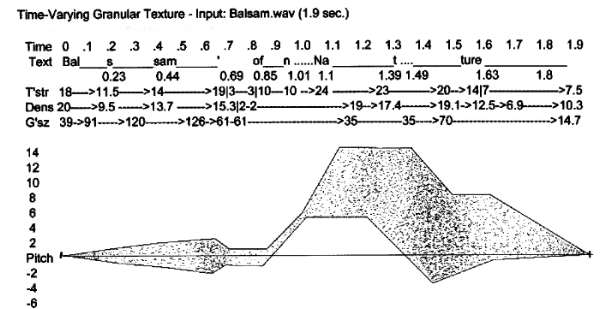
HITHER GATE MUSIC

HITHER GATE MUSIC

Goal: time-varying granulation of a text file, treating each syllable differently. The text is: 'Balsam of Nature'.
Firstly, a sound editor was used to display the soundfile and determine where the different consonants and syllables occurred. These time points were then used in the breakpoint files to 'unfurl' the sound in various ways.
Alternatively, you can extract the amplitude envelope of the sound, using File/Extract from sfile in the Breakpoint Editor. You will probably need to cut down on the number of time-points displayed, using Edit/Reduce; then you will have something manageable as a breakpoint file. You can then use this file directly as a starting point for time-contours related to the amplitude profile of the original sound.
The salient features of the sound, the spoken text can be shown as follows, with their time points.
Time-point analysis of sonic features Time-points 0.0 0.23 0.44 0.69 0.85 1.01 1.11 1.39 1.49 1.63 Syllables Bal .... s ...... sam .... ' of ..... n ...... Na ..... t ...... tu ..... ure .... The diagram at the top of the page shows a regular time grid, then the syllables of the text and their time onsets. Below that are three of the parameters used for shaping a granular texture: Timestretch, Density and Grainsize.
In this sound design illustration, all of these parameters change over time, that is, they have different values at different times. These values are written out in the diagram at the approximate times when they occur.
- Timestretch lengthens the amount of time each section lasts.
- Density controls the onset timing of the events, causing overlaps or gaps.
- Grainsize determines the length in milleseconds of each of the potentially thousands of grains of sound that will make up the texture.
Two more parameters are of crucial importance: the upper and lower pitch traces. This means the changing transposition levels. As shown on the diagram, these two traces make a shape with upper and lower boundaries. The grains are extracted from the sound, replicated as demanded by the timestretch and density parameters, and transposed to fill the space made by these pitch contours; they may not go beyond the pitch boundaries at any time.
Thus the diagram places note events within the pitch boundaries, at densities which represent schematically the density parameter values.
When we listen to the granular texture produced by this input sound and shaped by these parameter settings, we can easily hear the pitch shape the texture makes and how the timestretching, densities and grainsizes ebb and flow with the syllables of the text.
When making the sound, the values for these various parameters are inevitably tweaked over and over again, fine-tuning the final result.
For reference, the file listings below summarise the time-changing values of the various parameters. The only way to deal with planning such a texture is to draw out time-value traces for each of the parameters, however roughly. Then draw or type out the time-varying files, automation patterns using these drawings as reference.
TIMES TIMESTRETCH DENSITY GRAINSIZE (ms) PITCH-HI PITCH-LO 0.0 18.0 20.0 40 0 -0.7 0.1 91 0.2 11.5 9.5 1.16 -1.0 0.3 120 0.4 14 13.7 1.24 -1.0 0.69 2.9 15.3 61 2.18 -2.1 0.7 2 1.09 -1.1 0.77 61 0.80 3 0.83 10 0.85 2 1.09 -1.3 1.0 10 35 7.24 1.12 24 14 5.1 1.2 19 1.31 23 35 5.1 1.39 17 14 -5.4 1.49 20 70 8 1.59 14 19 1.63 7 12.5 8 -0.39 1.69 1.7 6.9 1.8 1.90 7.5 10.3 14 0.3 -0.05The ebb and flow of time-varying parameter values lends the music dynamism and direction.